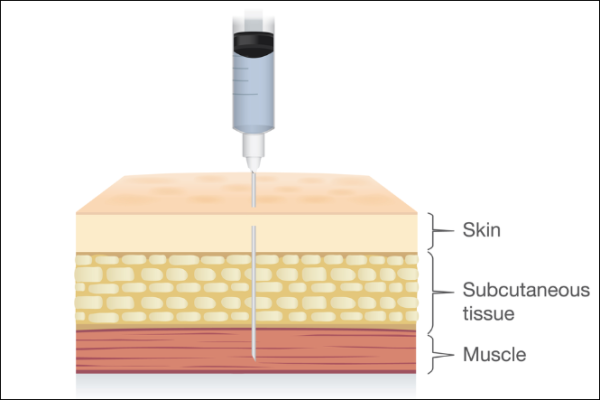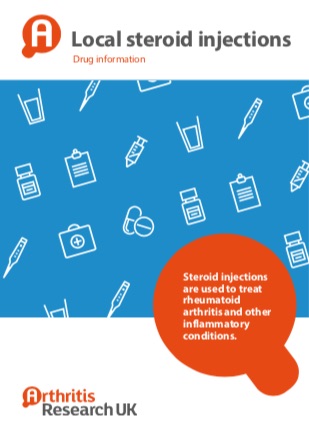Intramuscular injections
Intramuscular injections are also called IM injections
Key points about intramuscular (IM) injections
- An intramuscular injection is an injection into a muscle.
- Some medicines are given as an injection into a muscle if they can't be taken by mouth because the acids in your stomach affect the medicine.
- Find out how to take it safely and possible side effects.

An intramuscular injection (also called IM injection) gets medicine into the muscle that is found under a layer of fat that lies just beneath your skin.
(Healthify He Puna Waiora, NZ, 2020)

Image credit: Healthify He Puna Waiora
Some medicines are given as an injection into a muscle if they can't be taken by mouth because the acids in your stomach affect the medicine. These medicines are better absorbed when given into a muscle, which means they work better.
Some other types of intramuscular medicines are called depot injections. They slowly release a slow-acting form of your medicine. The carrier liquid in the injection releases the medicine slowly so it lasts a lot longer in your body.
Depot injections are usually given every few weeks or months, depending on the medicine. A depot injection might be a good option if you have difficulty swallowing medicine or remembering to take it regularly or if you prefer not to have to think about taking medicines every day.
Before you use an IM injection, make sure you have a discussion with your doctor about all the other medicines you are taking, including medicines you may buy from a health food store or over the counter.
IM injections may not be suitable for people who are taking some other types of medicines, or you may need to take special care.
Some medicines given by IM injection are:
- antibiotics
- contraceptive hormones such as Depo-Provera
- vaccines
- EpiPen (adrenaline injections for severe allergic reactions)
- antipsychotics (read more about depot antipsychotics).
An IM injection is usually given into muscles such as your thigh, bottom or upper arm. Some medicines need to be given in larger muscles such as your bottom, while others can be given in smaller muscles such as your arm. Your healthcare provider will tell you which area is best for your medicine.
Some IM injections are available as pre-filled syringes, which means the syringe is already filled with medicine and is ready for use. Other IM injections come in a small glass bottle or vial, so the dose needs to be measured using a needle and syringe. Your healthcare provider will tell you what dose is best for you and show you how to measure your dose if you need to give the injection yourself at home.
Always wash your hands with soap and water and dry them before giving an IM injection.
- The skin at the injection site should also be clean before giving the injection.
- If your skin looks dirty, wash the area with soap and water and pat it try, or use an alcohol swab and allow it to dry.
- If your skin doesn't look dirty, you don't need to clean it or use an alcohol swab before giving an injection.
After most injections, it is recommended that you relax and limit your activity for the remainder of the day unless you have been told otherwise by your doctor or nurse.
- You may shower but avoid soaking baths, hot tubs, whirlpools or swimming pools for a few days.
- You can exercise after having an IM injection, but it is a good idea to avoid strenuous exercise for several hours after the injection.
It is normal to get some pain and discomfort after an IM injection, but here are a few do's and don't to reduce the pain and discomfort.
| Do's | Don'ts |
| ✔ If your medicine is stored in the fridge, take it out of the fridge and bring it up to room temperature before you use it. You can also warm the medicine by rolling the syringe or vial between your hands for a few minutes. ✔ Change the area of injection, so you don't give it in exactly the same place as before. ✔ If you bleed, you can apply a little pressure to the injection site using your finger, cotton wool or a piece of gauze. ✔ Ask your doctor about whether you can take pain relief medicine like paracetamol. |
✘ Don’t use a medicine straight from the fridge. ✘ Don't warm your medicine by running it under hot water or putting it in the microwave. ✘ Don't inject into an area that is painful and red. ✘ Don't rub the area after the injection as this can cause bruising. |
Call your doctor if you get fever or chills or a lump, swelling, redness or bruising at an injection site that does not go away. This could be signs of an infection.
You must get rid of your used needles and syringes safely.
- Keep them out of reach of children and pets and places where they could hurt others. You can do this by buying a sharps container from your pharmacy.
- This is a special container made of hard plastic that has a tight-fitting lid so used needles and syringes can be stored securely.
- Don't flush used needles and syringes down the toilet or place them in household or public rubbish or recycle bins.
- Once your sharps container is full, take it to your pharmacy for safe disposal.
- Talk to your pharmacist about how you can get rid of your needles and syringes safely.

Image credit: Healthify He Puna Waiora
Giving an IM (intramuscular) injection(external link) Medline Plus, US
How to give an intramuscular shot – care instructions(external link) My Health, Canada
Resources
Local steroid injections [PDF, 164 KB] Arthritis Research UK
5 questions to ask about your medications(external link)(external link)(external link) Health Quality and Safety Commission, NZ, 2019 English(external link), te reo Māori(external link)
Brochures

Arthritis Research UK

Medicines and side effects
Healthify He Puna Waiora, NZ, 2024

Health Quality and Safety Commission, NZ, 2019
English(external link)Te reo Māori(external link)
Credits: Sandra Ponen, Pharmacist, Healthify He Puna Waiora. Healthify is brought to you by Health Navigator Charitable Trust.
Reviewed by: Angela Lambie, Pharmacist, Auckland
Last reviewed:
Page last updated:





